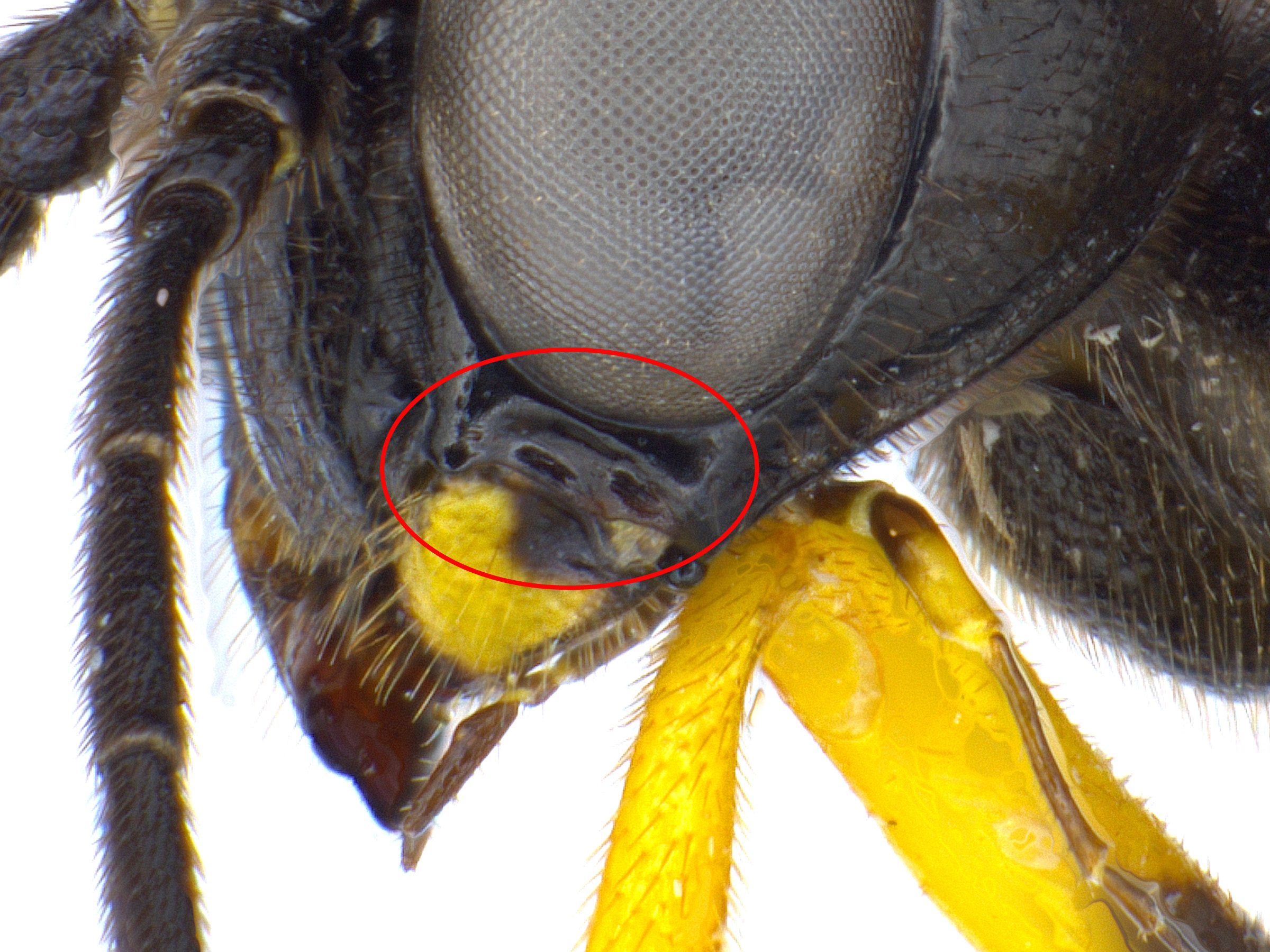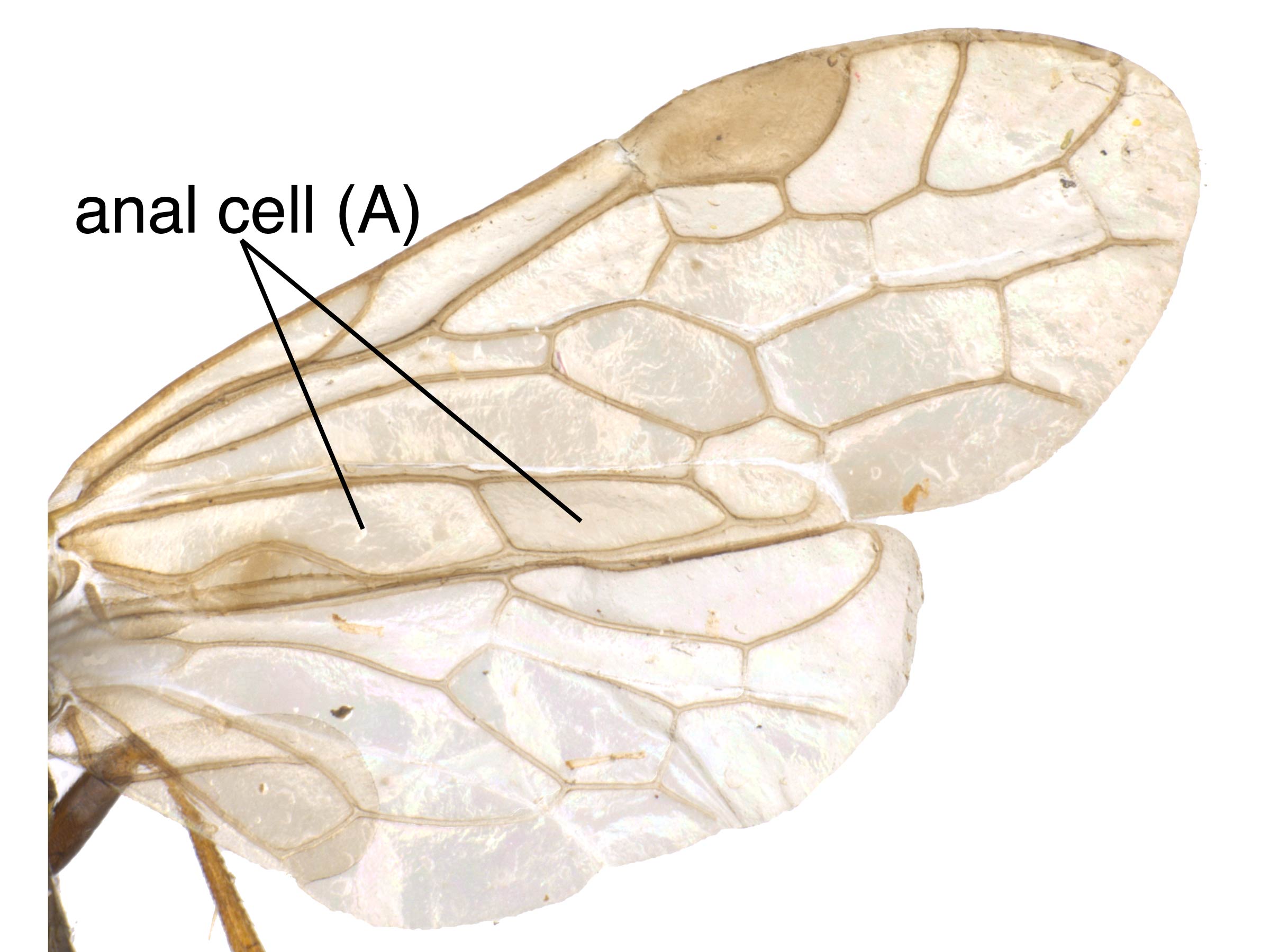Family: Tenthredinidae
Family common name: common sawflies
Subfamily: Heterarthrinae
Tribe: Caliroini
Genus: Endelomyia Ashmead, 1898
Subgenera: none
The Tenthredinidae are the most species-rich family and are found throughout the world, in all continents but Antarctica. They are known as the “common sawflies.” They can generally be recognized by a cylindrical body and long, segmented antennaeantenna:
the sensory organ emerging from the front of the head, usually between the compound eyes and above the clypeus; includes the flagellum, scape and pedicel
 . Otherwise, they come in a variety of colors, sizes, and forms (Goulet 1992Goulet 1992:
. Otherwise, they come in a variety of colors, sizes, and forms (Goulet 1992Goulet 1992:
Goulet H. 1992. The genera and subgenera of the sawflies of Canada and Alaska: Hymenoptera. Symphyta. The insects and arachnids of Canada. Part 20. Agriculture Canada Publication.).
Sawflies in the Heterarthrinae subfamily are generally small and dark-colored. Many species of this family are economic pests of trees and shrubs and can be characterized by their skeletonizing or leaf-mining larval feeding behaviors. Heterarthrinae adults can be distinguished from those of other subfamilies by wing venationvenation:
the network of veins on a wing
(Smith 1971aSmith 1971a:
Smith DR. 1971a. Nearctic Sawflies. III. Heterarthrinae: Adults and larvae (Hymenoptera: Tenthredinidae). Technical Bulletin, U.S. Department of Agriculture 1420: 1-84.).
Endelomyia is monotypicmonotypic:
describes having only one representative; ex. a genus that includes only one species
in North America. Endelomyia aethiops is small, about 4.5 mm in length, and entirely dark-colored with white striping on the legs and slightly darkened wings (Smith 1971aSmith 1971a:
Smith DR. 1971a. Nearctic Sawflies. III. Heterarthrinae: Adults and larvae (Hymenoptera: Tenthredinidae). Technical Bulletin, U.S. Department of Agriculture 1420: 1-84.). Unlike other genera in the subfamily, Caliroa and Endelomyia are external leaf feeders and not leaf miners (Goulet 1992Goulet 1992:
Goulet H. 1992. The genera and subgenera of the sawflies of Canada and Alaska: Hymenoptera. Symphyta. The insects and arachnids of Canada. Part 20. Agriculture Canada Publication.).
There are three described extantextant:
in existence; opposite of extinct
species. One species occurs in North America (Taeger et al. 2010Taeger et al. 2010:
Taeger A, Blank SM, and Liston AD. 2010. World Catalog of Symphyta (Hymenoptera). Zootaxa 2580: 1-1064.).
Subfamily characters
 M slightly constricted at apexapex:
M slightly constricted at apexapex: vein 2r present (Goulet 1992Goulet 1992:
vein 2r present (Goulet 1992Goulet 1992:Genus characters
 length about 0.1–0.2X diameter of antennal socket (Goulet 1992Goulet 1992:
length about 0.1–0.2X diameter of antennal socket (Goulet 1992Goulet 1992: veins 2A and 3A complete; complete anal cellanal cell:
veins 2A and 3A complete; complete anal cellanal cell: present (Goulet 1992Goulet 1992:
present (Goulet 1992Goulet 1992: (Goulet 1992Goulet 1992:
(Goulet 1992Goulet 1992: vein M curved near intersection with M+Cu (Goulet 1992Goulet 1992:
vein M curved near intersection with M+Cu (Goulet 1992Goulet 1992: anal cellanal cell:
anal cellanal cell: with an angled crossveincrossvein:
with an angled crossveincrossvein: with anal cellanal cell:
with anal cellanal cell: petiole (Smith 1967cSmith 1967c:
petiole (Smith 1967cSmith 1967c: with large basalbasal:
with large basalbasal:Endelomyia can be easily distinguished from other genera in the subfamily by the complete anal cellanal cell:
cell A of either the fore wing or hind wing
 with crossveincrossvein:
with crossveincrossvein:
short section of wing vein that connects two larger veins
, number of antennal segments, and narrow malar spacemalar space:
the minimum distance between the base of the mandible and the ventral margin of the compound eye
 (Goulet 1992Goulet 1992:
(Goulet 1992Goulet 1992:
Goulet H. 1992. The genera and subgenera of the sawflies of Canada and Alaska: Hymenoptera. Symphyta. The insects and arachnids of Canada. Part 20. Agriculture Canada Publication.). It can be confused with similar genus Caliroa, but is distinguished by the apicalapical:
towards the apex; farthest away from the body
flagellomeres (Smith 1967cSmith 1967c:
Smith DR. 1967c. A review of the subfamily Heterarthrinae in North America (Hymenoptera: Tenthredinidae). Proceedings of the Entomological Society of Washington 69: 277-284.).
none
Endelomyia aethiops in North America feeds on species of Rosa (rose) (Goulet 1992Goulet 1992:
Goulet H. 1992. The genera and subgenera of the sawflies of Canada and Alaska: Hymenoptera. Symphyta. The insects and arachnids of Canada. Part 20. Agriculture Canada Publication.).
Females oviposit into the edge of the leaf (Smith 1971aSmith 1971a:
Smith DR. 1971a. Nearctic Sawflies. III. Heterarthrinae: Adults and larvae (Hymenoptera: Tenthredinidae). Technical Bulletin, U.S. Department of Agriculture 1420: 1-84.). LarvaeLarva:
the immature stage of holometabolous insects
 feed on the underside of the leaf on the inter-vein tissue, skeletonizing the leaf. At maturity, the larvaelarva:
feed on the underside of the leaf on the inter-vein tissue, skeletonizing the leaf. At maturity, the larvaelarva:
the immature stage of holometabolous insects
 drop to the ground to overwinter. The species is univoltineunivoltine:
drop to the ground to overwinter. The species is univoltineunivoltine:
describing an insect with a life cycle of one generation per year
(Miles 1935Miles 1935:
Miles HW. 1935. Biological studies of certain species of Caliroa Costa and Endelomyia Ashmead (Hymenoptera Symphyta). Annals of Applied Biology 22 (1): 116-133. https://doi.org/10.1111/j.1744-7348.1935.tb07712.x). Endelomyia aethiops is an introduced species that has become a pest known as the roseslug, as it causes damage to ornamental roses (Stroom et al. 1997Stroom et al. 1997:
Stroom K, Fetzer J, and Krischik V. 1997. Insect pest of roses FO-6953-D. University of Minnesota College of Agricultural, food and Environmental Sciences.). Though its common name includes “slug,” the larvaelarva:
the immature stage of holometabolous insects
 do not have an associated slime and shine like similar species Caliroa cerasi (Smith 1967cSmith 1967c:
do not have an associated slime and shine like similar species Caliroa cerasi (Smith 1967cSmith 1967c:
Smith DR. 1967c. A review of the subfamily Heterarthrinae in North America (Hymenoptera: Tenthredinidae). Proceedings of the Entomological Society of Washington 69: 277-284.). It is also a pest in its native range and considered one of the most harmful insects of all rose pests (Gorlenko et al. 1984Gorlenko et al. 1984:
Gorlenko SV, Panko NA, and Podobnaya NA. 1984. Pests and diseases of rose. Nauka I tekhnika, Minsk, USSR. p 127.).
World: This genus is represented in North America, France, central and eastern Europe, and China (Liston et al. 2006Liston et al. 2006:
Liston AD, Taeger A and Blank SM. 2006. Comments on European sawflies. Pp. 245-263. In: Blank SM, Schmidt S, and Taeger A. eds. Recent sawfly research: synthesis and prospects. Goecke amp; Evers, Keltern., Wei et al. 2006Wei et al. 2006:
Wei M, Nie H, and Taeger A. 2006. Sawflies (Hymenoptera: Symphyta) of Chinamdash;checklist and review of research. Pp. 505-574. In: Blank SM, Schmidt S, and Taeger A, eds. Recent sawfly research mdash; synthesis and prospects. Goecke amp; Evers, Keltern., Taeger et al. 2010Taeger et al. 2010:
Taeger A, Blank SM, and Liston AD. 2010. World Catalog of Symphyta (Hymenoptera). Zootaxa 2580: 1-1064.)
North America: Endelomyia aethiops was introduced from Europe. It was first discovered in North America in the 1840s and is now widespread in the United States and southern Canada (Smith 1971aSmith 1971a:
Smith DR. 1971a. Nearctic Sawflies. III. Heterarthrinae: Adults and larvae (Hymenoptera: Tenthredinidae). Technical Bulletin, U.S. Department of Agriculture 1420: 1-84.).
Map data from: GBIF.org (29 October 2019) GBIF Occurrence Download Endelomyia
Details about data used for maps can be found here.